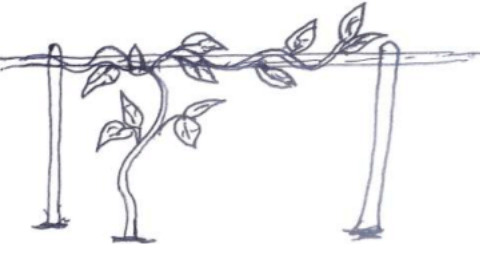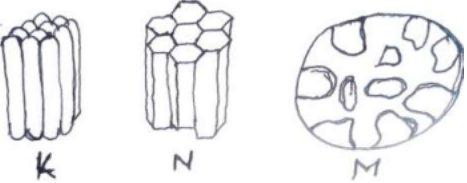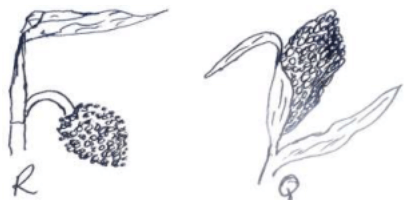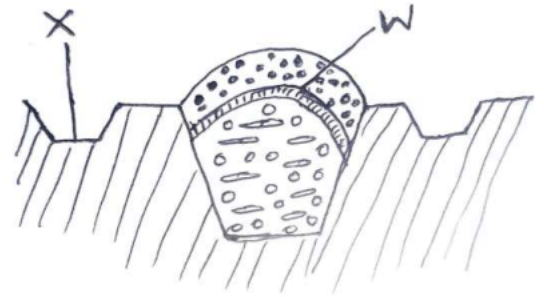INSTRUCTIONS TO CANDIDATES
- This paper consists of THREE SECTIONS, A, B and C.
- Answer all questions in sections A and B and two questions in section C.
SECTION A: (30 MARKS)
Answer all the questions from this section.
- State four features of rainfall a farmer should consider when deciding on a crop to grow. (2 mks)
- Mention four factors that affect effectiveness of a pesticide. (2 mks)
- State four advantages of using farm yard manure. (4 mks)
- State two ways by which organic mulch helps to conserve moisture in the soil. (2 mks)
- List four reasons for pruning in coffee. (2 mks)
- State four disadvantages of nomadic pastoration. (2 mks)
- State four practices that should be carried out to maintain grass pastures. (2 mks)
- Mention four advantages of minimum tillage in crop production. (2 mks)
- State four importance of keeping farm records in crop production. (2 mks)
- State four cultural methods of weed control in crop production. (2 mks)
- List four advantages of individual-owner operator in land tenure system. (2 mks)
- List four sites on which agroforestry trees can be established on al farm. (2 mks)
- State four methods commonly used for applying nitrogenous fertilisers. (2 mks)
- State four reasons for staking tomatoes. (2 mks)
- List four classes of livestock farming. (2 mks)
- State four types of soil erosion caused by water. (2 mks)
SECTION B: (20 MARKS)
Answer all the questions from this section.
- Study the diagram below and answer the questions that follow.

- Identify the field practice above. (1 mk)
- State two importance of the practice above. (2 mks)
- State two other practices aimed at providing support to weak stemmed plants. (2 mks)
- Study the diagrams below and answer the questions.

- Identify the soil structure labeled K and M. (2 mks)
- Differentiate between soil structure K and N. (1 mk)
- How can soil structure M be improved? (1 mk)
- The table below shows maize production from varying amounts of NPK on one hectare of land.
YEAR NPK TOTAL PRODUCT 2001 0 5 2002 50 12 2003 100 28 2004 150 47 2005 200 59 2006 250 65 2007 300 68 2008 350 70 2009 400 70 2010 450 68 - Calculate the farmer’s marginal product for year 2004 and 2005. (1 mk)
- Calculate the average product for the year 2008 and 2010. (1 mk)
- Assume the average price of fertilisers over the years recorded was Ksh 2000 per 50kg bag and the price of maize per bag who Ksh 3000, calculate the net revenue for year 2009. (2 mks)
- The diagrams below represent varieties of sorghum grown by farmers.

- Identify varieties R and Q (2 mks)
- Name the variety prone to bird attack. (1 mk)
- State two ways of controlling birds in sorghum field. (2 mks)
- Use the diagram below to answer the questions that follow.

- Identify the method of ensiling shown above. (1 mk)
- Identify the function of W and X. (2 mks)
- State two ways of preventing overheating. (2 mks)
SECTION C: (40 MARKS)
Answer any two questions from this section.
-
- Explain five properties of nitrogenous fertilizers. (5 mks)
- Mention five precautions observed in harvesting pyrethrum to ensure high quality product. (5 mks)
- State and explain five importance of drainage as a land reclamation method. (10 mks)
-
- Explain five roles of trees in soil and water conservation. (5 mks)
- State seven factors that contribute to competitive ability of weeds . (7 mks)
- Mention eight effects of fragmentation and sub-division of land. (8 mks)
-
- Explain five advantages of sub-surface irrigation system. (5 mks)
- Explain five contributions of agriculture to National development. (5 mks)
- Explain five non-human factors that encourage soil erosion. (10 mks)

MARKING SCHEME
SECTION A (30MKS)
- State 4 features of rainfall a farmer should consider when deciding on a crop to grow. (2mks)
- Rainfall amount
- Rainfall reliability
- Form
- Rainfall distribution
- Rainfall intensity
- Mention four factors that affect effectiveness of a pesticide (2mks)
- Concentration of the pesticide in relation to the stages of development
- The weather conditions.
- The persistence of the pesticide
- The formulation of the pesticide
- The mode of action of the pesticide.
- State four advantages of using farm yard manure. (4mks)
- Improves soil structure/water holding capacity
- Supplies a variety of soil nutrients
- Has a long residue effect
- Promotes microbial activities in the soil
- Buffers soil the PH/increases cation exchange capacity.
- Locally/easily available
- State two ways by which inorganic mulch help to conserve moisture in the soil. (2mks)
- Reduce evaporation
- Reduce surface run-off
- List four reasons for pruning in coffee. (2mks)
- To train the plant to desired shape and size
- To remove diseased and unwanted plant parts
- Control cropping/regulate bearing
- To facilitate picking/harvesting
- Control pest and diseases
- To ease penetration of spray
- State four disadvantages of nomadic pastoralism. (2mks)
- Low production
- Uncontrolled mating/breeding
- Difficult to control, diseases and parasites
- Lead to overgrazing and soil erosion
- State four practices that should be carried out to maintain grass pastures. (2mks)
- Top dressing
- Controlled grazing
- Topping/cutting back
- Reseeding/refilling of the gaps
- Control of pests e.g moles, termites
- Control of weeds
- Irrigation
- Mention four advantages of minimum tillage in crop production. (2mks)
- Reduce cost of production
- Control soil erosion
- Maintain soil structure
- Prevent exposure of humus to adverse condition
- Conserve moisture
- Prevent disturbance of roots
- State four importance of keeping farm records in crop production. (2mks)
- Help to compare the performance of different crop enterprises within the farm
- Guide farmer in planning and budgeting of farm operations
- Help detect losses or theft on the farm.
- Help in the assessment of the income tax.
- Help determine the value of the farm
- Make it easy to share profits and losses in partnership
- Help in settling disputes among heirs.
- Help to show whether the farm is making profit/losses
- Help in supporting insurance claims on death etc
- Provide labour information like terminal benefits
- State four cultural methods of used control in crop production. (2mks)
- Mulching
- Cover cropping
- Crop rotation
- Timely planting
- Use of clean seed/planting materials
- Proper spacing
- Clean seedbed
- flooding
- List four advantages of individual owner operator in land tenure system. (2mks)
- Provides the greatest incentive in farming, conservation and improvement of land
- Act as a security to obtain agricultural credits or loans
- The owner has an incentive for long-term investment in the land
- The owner can sell or give away the whole or part of the land.
- List four sites on which agroforestry trees can be established on a farm. (2mks)
- Farm boundaries
- Homestead
- Terraces
- River bank/water catchments areas
- Slopes/steep slopes
- Within pasture land/ between crops.
- Farm boundaries
- State four methods commonly used for applying nitrogenous fertilizers. (2mks)
- Broadcasting
- Side dressing
- Foliar spraying
- Drip
- Broadcasting
- State four reasons for staking tomatoes (2mks)
- Production of clean fruits
- Facilitates spraying and harvesting of the crop
- Controls Incidences Of Disease Outbreaks Such As Blight
- Prevents Infestation by soil borne pests
- Production of clean fruits
- List four classes of livestock farming. (2mks)
- Pastoralism(mammalian livestock farming)
- Fish farming(Aquaculture)
- Bee keeping (Apiculture)
- Poultry keeping
- Pastoralism(mammalian livestock farming)
- State four types of soil erosion caused by water. (2mks)
- Splash/raindrop erosion
- Sheet
- Rill
- gully
- Splash/raindrop erosion
SECTION B. (20MKS)
- study the diagram below and answer the questions.
- Identity the field practice above (1mks)
- Trelishing
- State two importance of the practice above (2mks)
- Support
- Ease harvesting/spraying
- Obtain clean fruit
- Support
- State two other practices aimed at providing support to weak stemmed plants. (2mks) - Staking
- propping
- Identity the field practice above (1mks)
- Study the diagrams below and answer the questions.
- Identify the soil structure labelled K and M. (2mks)
- K - platy structure
- M- Single grained structure
- Differentiate between soil structures K and N. (1mk)
- K rounded top while N has flat top/clear cut edges/prismatic
- K rounded top while N has flat top/clear cut edges/prismatic
- How can soil structure M be improved (1mk)
- Addition of organic matter
- Identify the soil structure labelled K and M. (2mks)
- The table below shows maize production from varying amounts of NPK on one hac of land. Year npk total product
- Calculate the farmer’s marginal product for year 2004 and 2005. (1mks)
- 2004 19
- 2005 12
- Calculate the average product for the year 2008 and 2010 (1mks)
- 2008 10
- 2010 7.56
- 2008 10
- Assume the average price of fertilizer over the years recorded was Ksh 2000 per 50kg bag and the price of maize per bag was Kshs 3000, calculate the net revenue for year 2009. (2mks)
Units of NPK used in 2009 is 8
Maize production in 2009 is 70 bags
Total cost= 8 x 2000 = 16000
Total revenue = 70 x 3000 = 210000
NR = TR − TC = 210,000 − 16000 = 194,000
- Calculate the farmer’s marginal product for year 2004 and 2005. (1mks)
- The diagrams below represents varieties of sorghum groom by farmers.
- Identify varieties R and Q. (2mks)
- R goose necked sorghum
- Q compact panicle
- R goose necked sorghum
- Name the variety prone to bird attack (1mk)
- Q/compact panicle and open panicle+
- State two ways of controlling birds in sorghum filed. (2mks)
- Using scaring devices destroy nest and roosting sites
- Bait poison
- Using scaring devices destroy nest and roosting sites
- Identify varieties R and Q. (2mks)
- Use the diagram below to answer the questions.
- Identify the method of ensiling shown above. (1mk)
- Trench silo
- Identify the functions of W and X. (2mks)
- w- prevent water and air entering into the silo
- x- to drain off rain water
- State two ways of preventing overheating. (2mks)
- Compressing material to reduce aerobic respiration
- Rapid filling of the silo
- Adding water to cool
- Allowing materials to wilt before ensiling
- Identify the method of ensiling shown above. (1mk)
SECTION C (40MKS)
-
- Explain five properties of nitrogenous fertilizer. (5mks)
- Highly soluble in water
- Easily leached to lower horizons hence are top-dressed
- Have a short residual effect therefore are applied frequently
- Have a scorching/burning effect on plants
- Are highly corrosive hence not handled with bare hands
- Are higly volatile hence applied on moist soil
- Are hygroscopic/absorb water from the atmosphere causing ‘caking’-store in a dry place
- Mention five precautions observed in harvesting pyrethrum to ensure high quality product. (5mks)
- Harvest flowers in open baskets
- Avoid compacting flowers in the basket
- Avoid picking wet flowers
- Picked flowers should be dried soon after harvesting to maintain the pyrethrum content
- Ensure flowers have no petiole/twigs/stem from the pyrethrum plant
- Only pick flowers with horizontal petals and having 2-3 rows of disc floret open
- State and explain five importance of drainage as a land reclamation method. (10mks)
- To reduce soil erosion- well drained soil have high water-holding capacity.
- To increase soil aeration- excess water from pores spaces is removed for plant roots to get air
- To increase soil volume- amount of soil around the root zone increases hence plant easily get nutrients
- To increase microbial activities- organisms get enough air
- To remove toxic substances soluble salts increase in waterlogged conditions, hence drainage removes them.
- To raise soil temperature- improves rate at which soil warms up
- Explain five properties of nitrogenous fertilizer. (5mks)
-
- Explain five roles of trees in soil and water conservation. (5mks)
- protect soil from raindrop erosion/reduce force of raindrop on the ground
- provide shade/reduce loss of moisture through evaporation
- act as a wind break
- Leaves/organic matter decays to improve infiltration rate of soil.
- Roots of trees bind/cement soil particles together
- Reduce speed of surface run off
- State seven factors that contribute to competitive ability of weeds. (7mks)
- Ability to produce many seeds
- Seed remain viable for a long time
- Most weeds are easily and successfully dispersed
- Have ability to survive where there is limited nutrient supply.
- Mention eight effects of fragmentation and sub-division of land. (8mks)
- Time and money is wasted while travelling from one holding to another
- No proper/effective weed and pest control
- Difficult to carry out sound/ proper farm planning
- Difficult to supervise the land
- Low agricultural productivity
- Difficult to mechanize small pieces of land
- Difficult to offer agricultural extension services
- Difficult to carry out soil and water conservation measures
- Difficult to control livestock diseases and parasites as animals move from one field to another. -
- Explain five roles of trees in soil and water conservation. (5mks)
-
- Explain five advantages of sub-surface irrigation system. (5mks)
- minimum labour requirement
- can be practiced on both sloppy and flat land
- does not cause soil erosion
- water under low pressure can be used
- does not encourage weeds between roots
- fungal attack is reduced because there is no accumulation of water on leaves
- economizes on the use of water/little water required
- theft of pipes is minimized
- Explain five contributions of agriculture to National development. (5mks)
- supply food
- source of raw materials for industries
- provide market for industrial expansion
- create international relationships
- improvement of infrastructure
- create employment opportunities
- Explain five non-human factors that encourage soil erosion. (10mks)
- amount/ intensity of rainfall – Heavy rains make top soil to be saturated with water
- Slope/topography – very steep slopes increase speed of run of thereby increasing erosion.
- Type of soil- sandy soil becomes saturated easily
- Soil depth- shallow soils become saturated with water very fast
- Vegetation cover- lack of vegetation cover exposes soil to erosive forces/agents thereby increasing erosion
- Explain five advantages of sub-surface irrigation system. (5mks)
Download Agriculture Paper 1 Questions and Answers - Lanjet Joint Mock Exams 2022.
Tap Here to Download for 50/-
Get on WhatsApp for 50/-
Why download?
- ✔ To read offline at any time.
- ✔ To Print at your convenience
- ✔ Share Easily with Friends / Students
